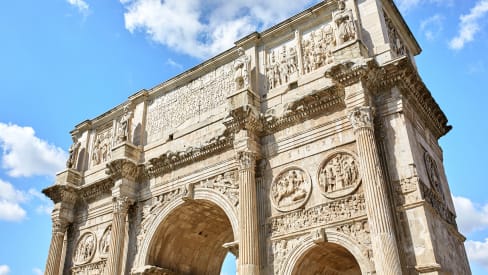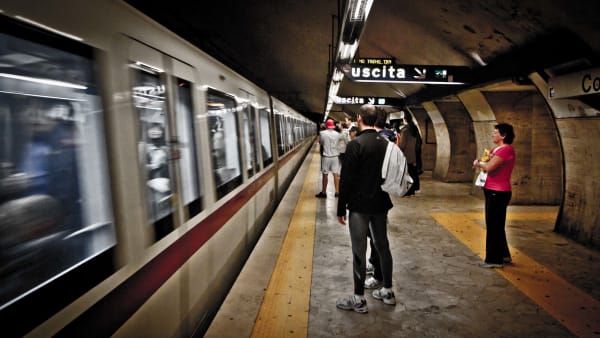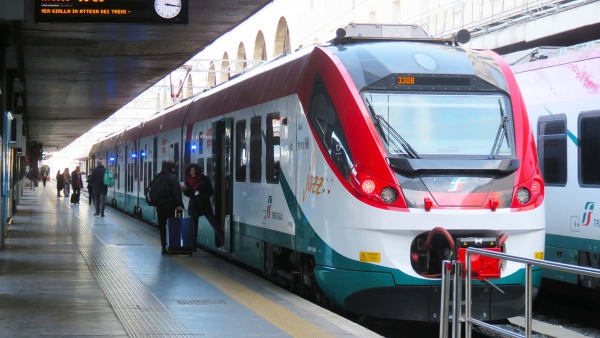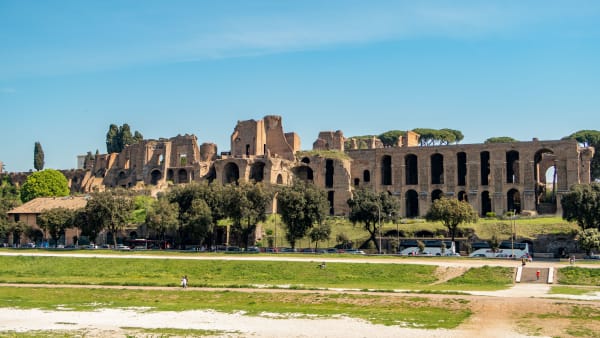Architectural elements
Architectural elements
As mentioned earlier, the monument is rich in majestic elements and decorations from different periods of Roman history. Thus, multiple art styles were eventually united in it. Some of the most relevant elements, are mentioned in the historical section of this article and will be explained in more detail below.
Structure and components
The columns of the monument are made of marble. However, the attic consists of a mixture of different types of marble reused from older monuments, as do most of the architectural elements and sculptures of the arch.
The monument consists of three arches, and the central one, which is the largest, is 6.5 m long and 11.45 m high, while in total it’s 21 m high including the attic, 25.70 m wide, and 7.40 m deep. The attic alone is 21 m high and 26 m wide.
The structure of the work resembles that of the Arch of Septimius Severus on the Roman Forum. It consists of three arches framed by columns standing on high pedestals and some decorative themes such as the victories in the parapets of the central arch.
The cornice is from the Antonine or Severine period. The Corinthian capitals, also from the Antonine period, the shafts of old yellow marble and the bases of the columns were also reused. The archivolts crowning the upper part of the central arch, the corbels, plinths, frieze, architrave, and bases of the main order, archivolts and impost corbels of the side arches, which are not aligned, all date from the Constantinian period.
The distribution of reliefs is symmetrical over the two facades (north and south) and the two short sides (east and west) of the arch. Traditionally, Roman arches decorated with reliefs feature war scenes on the outer (southern) facade, while peace scenes predominate on the inner (northern) facade, which faces the city.
On the attic of the monument, we find relief pairs from the time of Marcus Aurelius, while on the smaller sides can be seen slabs belonging to a frieze from the time of Trajan. In the lower part are pairs of tondos from the time of Hadrian and others from the time of Constantine. Other bas-reliefs are found above the arches and on the pedestals of the columns.
The “good” emperors
The protagonists of the reliefs are the so-called “good emperors”, being Trajan, Hadrian, and Marcus Aurelius, whom Constantine hoped to emulate and with whom he wanted to be associated, also for political purposes.
Let’s not forget that the emperor had to legitimize his succession after the defeat of Maxentius. So it was partly a propaganda strategy to present himself ideologically as the one who would revive the glorious era of the second century and the three emperors mentioned above.
This strategy was also reflected in the decision to manipulate the faces of the beloved emperors in relief in such a way that it seemed that Constantine was a direct heir to them. The new statues were even provided with an element, recognizable as a kind of precursor to the halo, called the nimbus, to emphasize his grandeur and majesty.
Sculptures
The surface of the Arch is covered with sculptures that date from different periods in Roman history. Many of these sculptures weren’t even made by Constantine. He was reusing them from earlier monuments that had been built by earlier emperors.
Like mentioned earlier, Constantine seemed to associate himself with emperors Marcus Aurelius, Hadrian, and Trajan. He showed this by incorporating sculptures from their monuments into his own.
Let’s take a look at the different elements coming from specific periods.
The era of Trajan (98-117 AD)
From the time of Trajan date the eight statues (made of pavonazzetto marble) of the Dacian prisoners on the attic. These freestanding figures are borrowed from monuments belonging to the emperor Trajan. Dacia was more or less what we call Romania, an area that had been previously conquered by the emperor Trajan. The statues are easily identifiable as non-Romans, or barbarians (foreigners), by the fact that they have beards and by their clothing.
On the two smaller sides of the attic, between de statues of the Daciers, are two panels with battle scenes from the era of Trajan. These belong to one large frieze of around 3 meters high and originally more than 35 meters long, originating from Trajan’s Forum.
The Dacian frieze and the reliefs of Trajan’s column were most likely made by the same artist. Not only the style is very much alike but also the scenes are similar such as the one in which Trajan receives the heads of two Dacian chiefs and the one in which the cavalry is attacked.
The last two major panels from this period are found inside the main archway. On one side, there’s an inscription that translates “bringer of peace” (FVNDATORI · QVIETIS). Below it, you see Constantine being crowned by a figure of victory, with a battle scene in the background. The opposite panel shows Trajan on horseback, trampling a barbarian, and the inscription above reads “Liberator of the city” (LIBERATORI · VRBIS). These two enormous inner panels are from the era of Hadrian, but he made them not of his own exploits, but of the previous emperor, Trajan.
The era of Hadrian (117-138 AD)
Under the attic, you can see the pilasters and columns with corinthian capitals. And in between those columns, there are roundels of more than 2 m high. The attribution to the emperor is due to stylistic factors and especially to the presence of the figure of Antinous, known for his love affair with Hadrian.
On the south side, from left to right, the scenes in round frames represent:
- The departure for the hunt.
- A sacrifice to the god Silvanus.
- A bear hunt.
- A sacrifice to the goddess Diana.
On the north side, from left to right, you can see:
- A boar hunt.
- A sacrifice to the god Apollo.
- The aftermath of a lion hunt.
- The sacrifice of Hercules.
The right roundels on the north side, are placed against a field of purple porphyry, which is an extremely expensive and semiprecious stone.
In addition, there are two inscriptions above the roundels. On the north side is written “VOTIS - X - VOTIS - XX” and on the south side “SIC - X - SIC - XX”. These refer to the celebrations of the ten and twenty years of Constantine’s reign.
In the scenes, the emperor is assisted by two or three figures, on horseback in two of the hunting reliefs and on foot in the others. The compositions are meticulously arranged around the imperial figure and the backgrounds are essential, following the conventions of Hellenistic art.
The era of Marcus Aurelius (161-181 AD)
The recurring theme of the subjugation of foreign peoples to the power of the Roman Empire is especially reflected on the eight panels (four on the south and four on the north side), between the statues of the Dacians. The rectangular reliefs, over 3 meters high, are scenes from Marcus Aurelius’ battles against the Quadi and the Marcomanni in 175 AD.
On the south side of the monument, from left to right, is shown how Marcus Aurelius:
- Presents a foreign king that has been captured.
- Receives barbarian (foreign) prisoners.
- Speaks to his soldiers.
- Makes a sacrifice before a battle.
On the north side of the monument, from left to right, you can see:
- The arrival of Marcus Aurelius into Rome;
- his departure of Rome.
- The distribution of largesse (money).
- The submission of the barbarian prisoners.
The beautiful reliefs are sculpted in classical style—of the ancient Greek and Roman tradition. The figures are in complex poses and there’s a high degree of naturalism (the faithful representation of the observable world). Many figures stand in contrapposto (an asymmetrical stance with weight shifted) and their drapery reveals the form of their bodies underneath, in three-dimensional folds.
It’s believed that the panels came from a now non-existent arch dedicated to Marcus Aurelius on Capitoline Hill. Another hypothesis is that they belonged to the complex that his son Commodus had built in his honor on the Campus Martius, of which only the Colonna Antonina (column) now remains.
The era of Constantine (312-315 AD)
Above the side arches and below the Hadrianic roundels is a frieze measuring just under 1 m high, which also continues on the short sides of the monument. During the time of Constantine, these reliefs were carved directly from blocks of masonry. This period is characterized by drastic artistic changes from the earlier classical tradition.
The story, which refers to the episodes of the war against Maxentius and the celebration of Constantine’s victory in Rome, begins on the short west side and runs counterclockwise around the arch.
On the west side of the arch, Constantine’s army is shown, making its way to Verona to attack the army of another Roman emperor, Maxentius. The panel next to it shows Constantine laying siege to the city of Verona and Maxentius’ troops.
Just to clarify: for some time, the Empire had been ruled by two senior and two junior emperors (tetrarchy). Licinius and Maximinus were responsible for the east. And Constantine was one of the emperors that were responsible for the Western Empire and went to battle against his co-ruler, Maxentius.
Then, on the south side, across the large bay is the most famous scene—the Battle of the Milvian Bridge. This is when the two armies confronted each other, just outside of Rome. Constantine defeats Maxentius, who’s killed at the battle, and is therefore in charge of the western part of the Roman Empire.
The panel on the east side, shows Constantine entering the city of Rome. And on the north side, the two final panels show the distribution of money to the Senate and the Roman people.
Below the frieze telling the story of the emperor, some spandrels and sculptures also date from the time of Constantine. Most of these show victory figures, some of them include roman gods, and also the seasons. Then, on the pedestals of the columns, you see additional relief carvings which show victories and subjugated barbarians.
Lastly, on the short sides of the arch are two roundels, also sculpted in the Constantinian period. On the east side, the sun god Apollo rises from the sea on a quadriga, while on the west side, the moon goddess Diana controls a chariot that plunges into the Ocean. The two reliefs reflect the emperor’s victory in a cosmic dimension.















